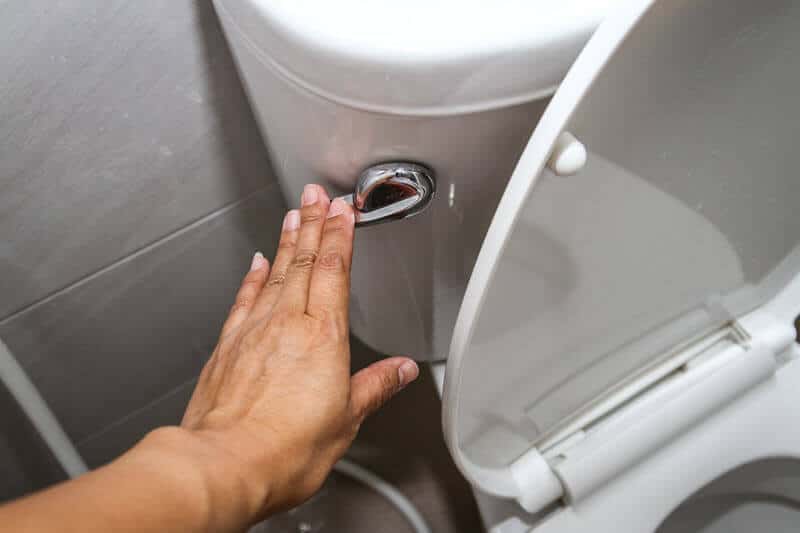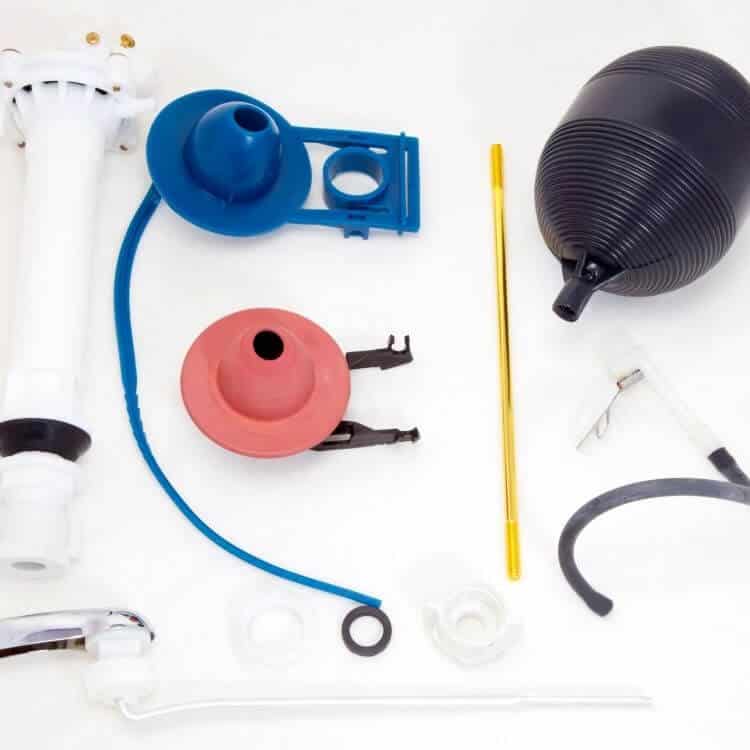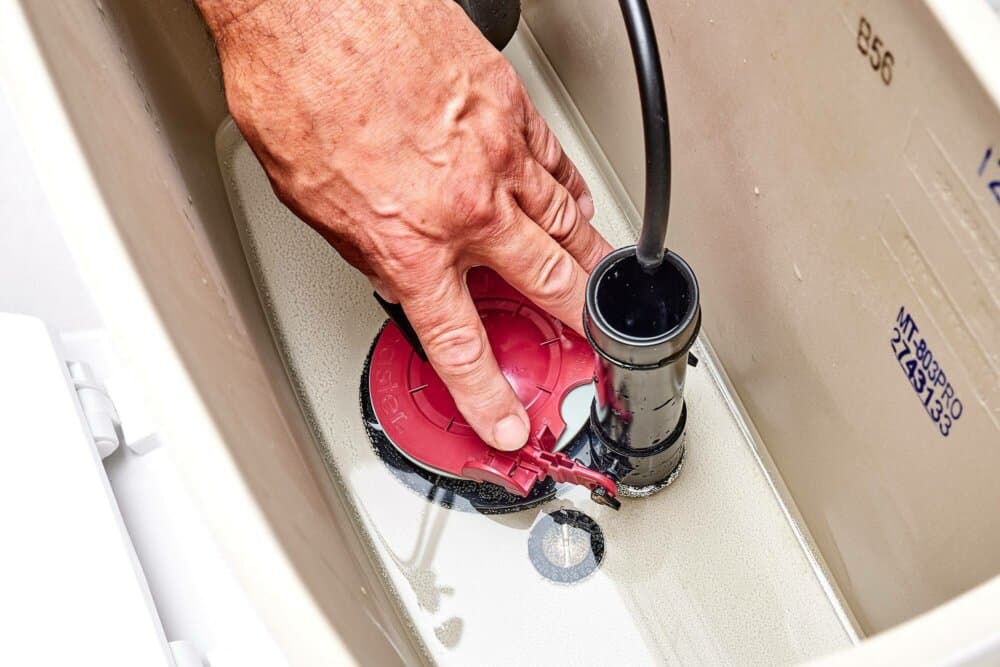Do you constantly deal with water drips and drops from your toilet every time you flush? A leak when flushing toilet can not only be annoying, but it can also be costly in the long run.
You may think water on the floor around the base of your toilet is not a big issue, but it can be if you ignore this problem for a longer period of time. Sometimes the cause of the toilet tee bolts, other times it is the cracked toilet tank.
In this article, we will guide you through identifying the cause of the leak and then suggest solutions for different causes.
Detecting the Leak When Flushing Toilet

It’s not so common that old residential toilets could waste 20% more water. They are also prone to leaking. [1]
People often don’t even realize that toilets can break, but leak when flushing toilet proves otherwise. The wet bathroom floor is no joke, in more ways than one.
Not only you can slip and fall, but this also indicates a very serious problem – either with your plumbing or with the toilet bowl.
It’s always better to act on time, as a leak when flushing toilet can turn into a much more serious matter if left unattended.
There is a few simple ways to detect leaking:
- Listen for the sound of running water after you flush the toilet. If you hear water running after the tank is refilled, it could indicate a leak.
- Check the water level in the toilet bowl. If the water level is higher than normal, it could indicate a leak.
- Inspect the base of the toilet for any signs of water damage or staining. This could indicate a leak.
- Put food coloring in the tank and wait 10-15 minutes, if you see the color in the bowl it means that the water is leaking from the tank to the bowl.
- Use a moisture meter to check for high moisture levels around the base of the toilet.
A Quick Tip
Don’t flush water from your toilet during the inspection, or right before it, even if you want to check where’s the leak coming from.
Larger amounts of leaking water from your toilet will only cause unpleasant odors in your bathroom. Further, standing water can cause structural damage to your entire property.
What is even worse, if your affected bathroom is on the second floor, the water will probably leak through the first-floor ceiling as well.
You should always inspect the entire toilet, including the bowl itself, the inside of the tank, and the water supply valve.
Sometimes, it’s enough to simply tighten nuts and bolts, but this isn’t always the case. On rare occasions, you may even have to replace the entire bowl.
If you don’t have the required tools, or you aren’t certain in your handiness skills, it’s better to call the plumber. Don’t risk causing a bigger issue than it already is.
There are several reasons why a toilet may leak when flushed:
- A worn out flapper valve in the toilet tank that allows water to leak through into the bowl.
- A malfunctioning fill valve that allows water to overflow into the bowl.
- A cracked or damaged toilet tank or bowl.
- A misaligned or clogged flush valve that prevents the toilet from flushing properly.
- A problem with the wax ring seal between the toilet and the drain.
- A broken or loose toilet handle that prevents the flapper valve from closing properly.
- A clogged or blocked toilet drain that causes water to back up into the bowl.
Also, it’s important to thoroughly inspect the location of the leak.
There are a few places where the leak may happen:
- At the base of the toilet
- Top of the tank
- Pipe under the toilet leaking
- Leak between tank and bowl
Grab a wrench and check out to see if everything is in its place. If nothing of this works, you should go on and check the gasket, or water supply line.
We’ll address everything in more detail in just a minute. Sometimes, if your toilet isn’t installed properly, or if you have a toilet rough in dimensions, this might cause the leak.
If this is the case, nothing else will work but replacing the toilet bowl altogether. Anything else can likely be repaired.
However, before you begin fixing a leak when flushing toilet, there are a few precautionary measures you should take.
First off, always wear rubber gloves.
Wastewater is dirty and you never know how your skin will react to it.
Read Also: Toilet Flushes But Waste Comes Back
You should also have a bucket and an old towel or piece of cloth nearby, in case any more water starts running from the toilet.
It would be best to turn the water supply entirely when dealing with any leaking toilet pipe, or any other plumbing. Ensure the water is drained from the toilet before you begin.
How to Fix a Leak when Flushing Toilet?

Once you have found what’s causing a leak when flushing toilet, it’s time to try to fix the issue.
Keep in mind that various issues might require different fixes.
Here are some of them.
What to Do When the Flapper Is the Problem

You’ll know the problem is in your flapper if your toilet flushes twice. It can also cause a toilet leaking from top of tank when flushed.
If you’re still unsure if the flapper is the issue, squeeze several drops of food coloring inside the toilet tank. In case that after a few minutes the coloring leaks into the toilet bowl but you never flushed, then this is the issue.
Assuming you’ve already shut off the water valve, remove the toilet tank, and examine the flapper. The flapper is that part of the toilet in the tank that lifts once you flush.
If the rubber on it is hard and not pliable, you should find a good replacement online or at the hardware store.
To replace it, just snap it off to remove it from the flush handle chain. Then, simply pop the replacement flapper into its place and attach it back to the chain.
Turn the water on and try flushing to see if everything works properly. If it works, but the water is still leaking, then something else is causing this issue.
What to Do When the Gasket Is the Problem
If you suspect the gasket is the culprit, the first thing you should do is disconnect the toilet tank from the toilet. A good sign that this might be causing it is toilet leaks when flushed at base of the tank.
To remove the toilet tank safely, you’ll need to:
- Shut down the water valve and ensure the tank is empty
- Loosen the nuts that are located on the hold-down bolts using both a screwdriver and a wrench
- Loosen the jamb nut
- Release the tank from the bowl
Once you’ve done this, you should look at your gasket and see if it’s cracked or dried out. If it is, you’ll need to remove the old gasket. This isn’t difficult to do.
You should be able to simply pop the gasket off. Then, you should easily just replace it with a new gasket. Once you’re done, place the tank back on the bowl and insert the bolts you’ve removed previously.
Make sure you don’t overtighten the nuts, or the porcelain might crack.
What to Do When the Water Pipe Is the Problem

Sometimes, if you notice the toilet leaking through the floor when flushed, you might be having an issue with the water supply line.
The same goes if you have a bathroom on the upper floor, then you notice toilet leaks through ceiling when flushed.
This could mean you have an issue with the pipe that connects the tank to the sewer system, either in the wall or underneath the toilet bowl.
Sometimes, the water might be just leaking from the fittings. This is a good sign, as you can simply tighten them – once again, make sure you don’t go overboard.
However, if you have leaks in the water supply line and the pipes, this isn’t something you can fix by yourself. It’s essential to contact the plumber as soon as possible, as only they can fix such damages.
Pipe cracks are no joke, and they can end up rather costly. Some might even damage the entire structure of your home. [2]
Read Next: Kohler vs American Standard Toilet
Bottom Line
Even though the leak when flushing toilet doesn’t seem like a big issue, the truth is it can be. A small leak or wet bathroom floor can be a sign of something much more severe. Try locating the source of the leak and see if you can fix it yourself using the tips we’ve given you. If not, contact your local plumber as soon as possible to avoid greater damages.

Michael Davis is a heating & plumbing expert who currently works as independent contractor in SC. He also writes for Plumbertip.
For almost 10 years he worked on various plumbing tasks across South Carolina.



